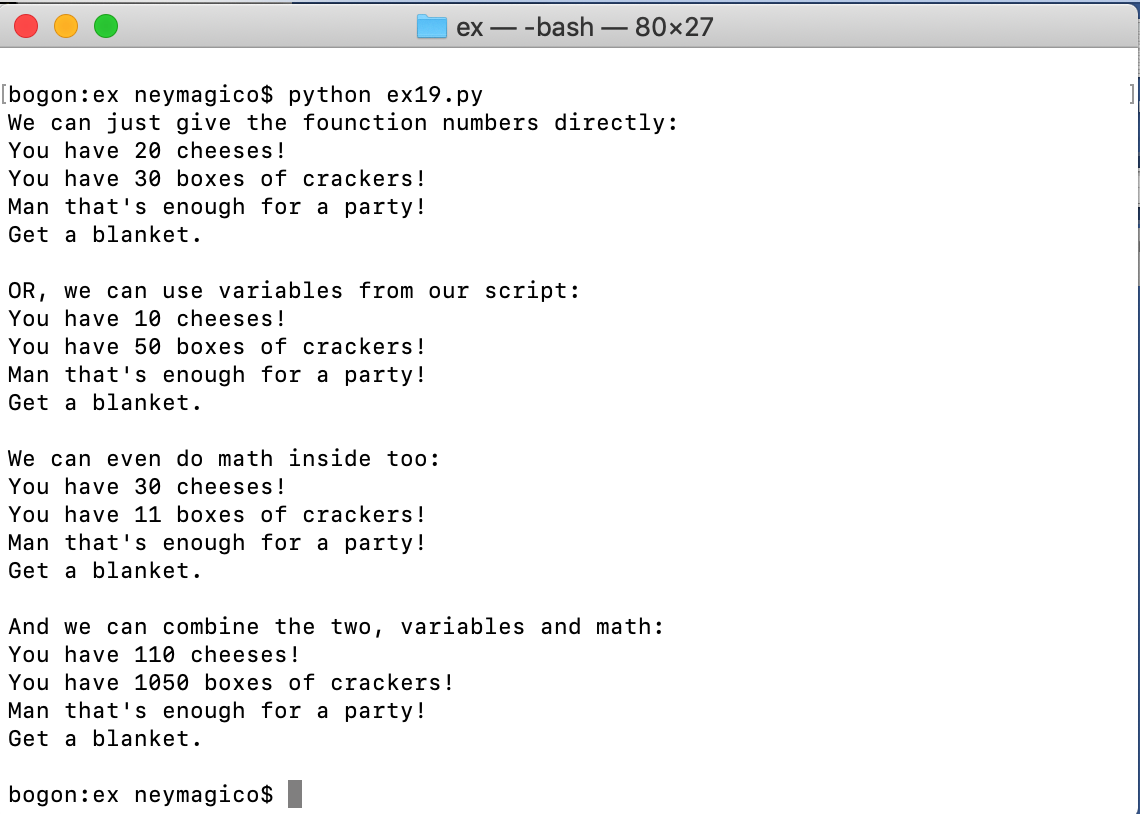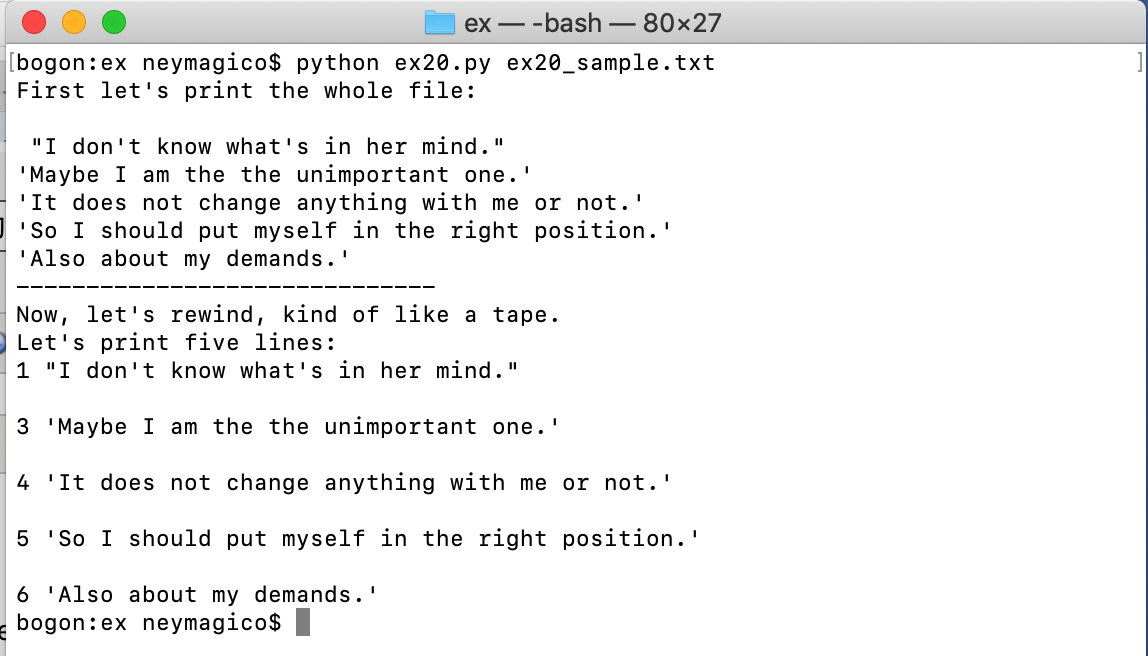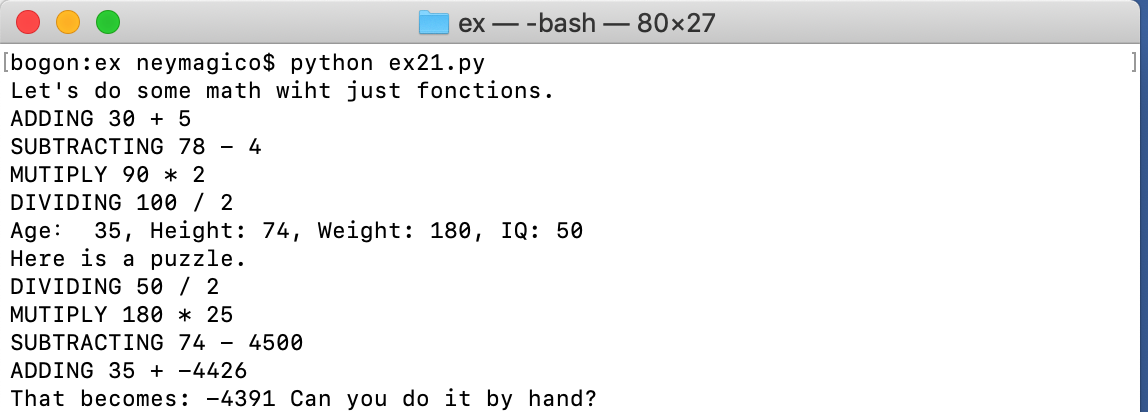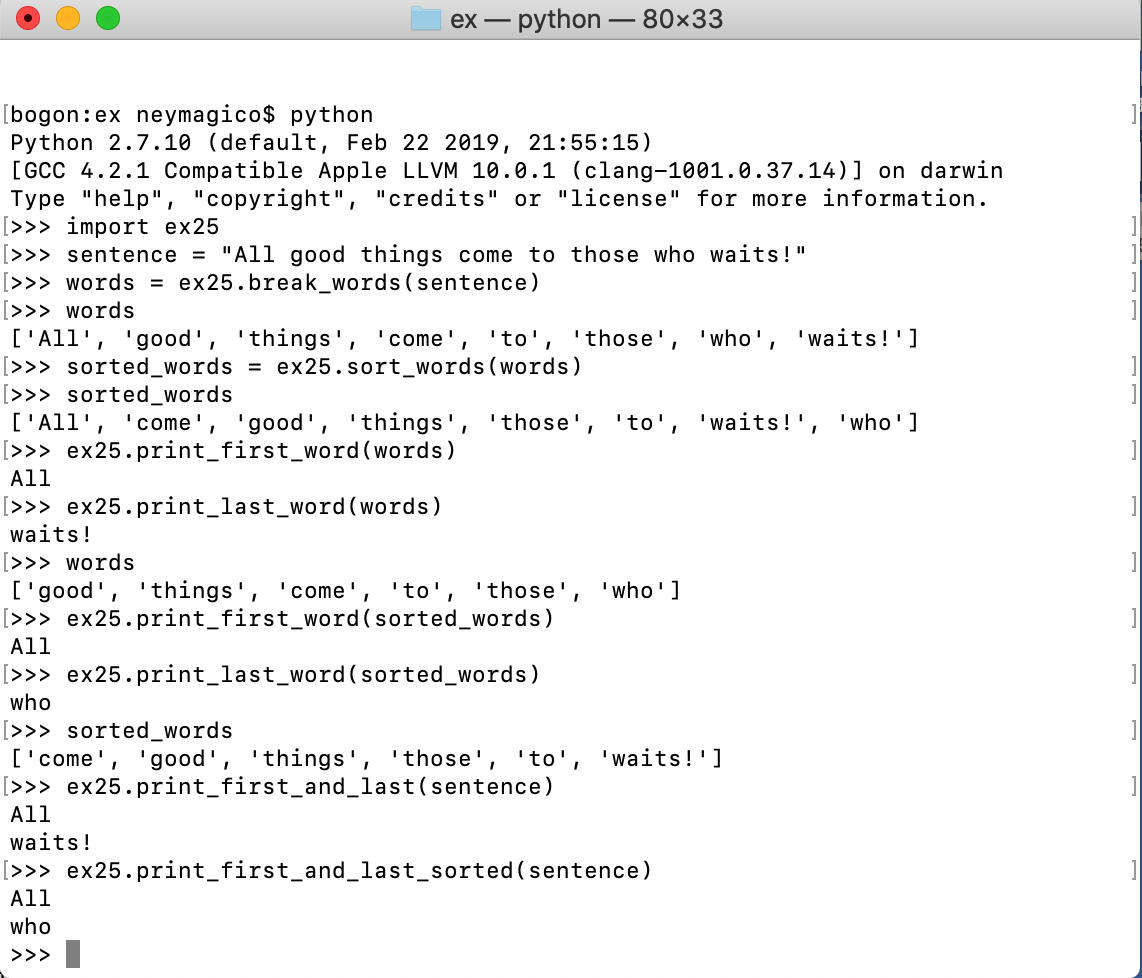一个“MacBook”新手的Python“笨办法”自学之旅 #第九章:Python的函数
第九章:Python的函数function
---------------------------------<习题18&19:命名、变量、代码、函数>------------------------------
除了Python自带的函数外,你还可以在Python环境下定义自己的函数,没错,是可以创造自己的函数。这个函数可以接受参数,方式跟我们前面学到的一样,可以用raw_input()或argv。
命令def:它的意思是“定义define”,如同定义变量一样,定义函数也是用“def”这个命令;
在def后面,空一格,然后键入函数的名称(你可以自由选择,但最好是能体现函数的功能,和变量的取名一样,不能用数字,但可以用字幕开头的名字,例如a1),再然后用“冒号:" 来收尾,表面下面的内容是该函数的内容;冒号后另起一行,需要使用4个空格缩进,表示缩进的代码是被包含在上面定义的函数内部。
下面展示书中四个函数的例子,ex18.py的代码如下:

1 #-*-coding:utf-8-*- 2 3 # this one is like your scripts with argv 4 def print_two(*args): #def 是命令define的缩写,定义的意思。此处用来定义一个函数print_two(), 5 #后面的冒号,表示冒号后面的内容,是该函数的内容,即该函数是一个输出字符串的函数 6 arg1, arg2 = args 7 print "arg1: %r, arg2: %r" % (arg1, arg2) 8 9 # ok, that *args is actully pointless, we can just do this 10 def print_two_again(arg1, arg2): #相对于第一个函数,没有使用参数解包的过程, 11 #而是直接在函数的括号内输入变量名 12 print "arg1: %r, arg2: %r" % (arg1, arg2) 13 14 # this just takes one argument 15 def print_one(arg1): 16 print "arg1: %r" % arg1 17 18 # this one takes no arguments 19 def print_none(): 20 print "I got nothing'." 21 22 23 # 下面四行代码,是为了运行上面的四个函数,直接键入函数的名称,并在函数的括号内写入该函数的参数即可 24 print_two("Zed", "Shaw") 25 print_two_again("Zed", "Shaw") 26 print_one("First!") 27 print_none()
终端运行结果如下:

注意:请一定要将函数相关的定义和使用弄清楚,因为可能会跟后吗学到的“类class”弄混,我现在也不能完完全全地讲出这两则的区别,希望再学到“类class”的时候会弄清楚,届时会针对函数和类的区别做一个解释
在习题19中,书中讲到几种函数的参数传递方式,ex19.py代码如下:

1 #-*-coding:utf-8-*- 2 def cheese_and_crackers(cheese_count, boxes_of_crackers): 3 print "You have %d cheeses!" % cheese_count 4 print "You have %d boxes of crackers!" % boxes_of_crackers 5 print "Man that's enough for a party!" 6 print "Get a blanket.\n" 7 8 9 print "We can just give the founction numbers directly:" 10 cheese_and_crackers(20, 30) #直接用数值赋予函数的输入 11 12 13 print "OR, we can use variables from our script:" 14 amount_of_cheese = 10 #该变量在此时赋予的数值,可运用于其它相同的变量名的值, 15 amount_of_crackers = 50 #该变量在此时赋予的数值,可运用于其它相同的变量名的值, 16 17 cheese_and_crackers(amount_of_cheese, amount_of_crackers) #利用已被赋予数值的变量,作为函数的输入 18 19 20 print "We can even do math inside too:" 21 cheese_and_crackers(10+20, 5+6) #可以用算式作为函数的输入 22 23 24 print "And we can combine the two, variables and math:" 25 cheese_and_crackers(amount_of_cheese +100, amount_of_crackers + 1000) #可以用字符串和数字的和,作为函数的输入参数
终端运行结果如下:

我自己也用两种不同的方式,完成函数参数的传递:raw_input()和argv
ex19_2.py用的是raw_input(), 我就不在贴上终端运行结果了:

1 # -*-coding:utf-8-*- 2 # 不好意思,我在辞职之前,是建筑公司的一名电气工程师,平时会涉及到电缆cable数量的统计工作,于是 3 # 就写了下面这个脚本。 4 5 print "we can use raw_input() for inputing all the arguments" 6 print "Now you can type in your arguments" 7 8 print "How many zones there are ?" 9 zones = int(raw_input()) #将输入的str强制转换成int,与第25行的变量要求一致 10 11 print "How many levels each zones?" 12 levels = int(raw_input()) 13 14 print "How many layouts in each levels?" 15 layouts = int(raw_input()) 16 17 print "How many types of cables in each layouts?" 18 types = int(raw_input()) 19 20 print "The quantity of each kind of cable:" 21 quantities = int(raw_input()) 22 23 def len_cables(zones, levels, layouts, types, quantities): 24 # 函数名和函数的参数的定义,注意括号和最后的冒号 25 length_cables = zones * levels * layouts * types * quantities 26 print "There are %d zones in project Thalassa" % zones 27 print "Each zone has %d levels" % levels 28 print "Each level has %d layouts" % layouts 29 print "Each layout has %d types of cables" % types 30 print "Each type of cables has %d meters" % quantities 31 print "The length of cables equals %d" % length_cables 32 # 函数的参数必须是4个空格的缩进 33 34 35 len_cables(zones, levels, layouts, types, quantities)
ex19_3.py用的是argv,值得注意的是,这里函数的参数的类型和变量的类型产生冲突,为了解决,我使用了int()将字符串强制转换成数值类型,详情见代码:

1 # -*-coding:utf-8-*- 2 3 print "We can use argv to input the arguments:" 4 5 from sys import argv 6 7 name, zones, levels, layouts, types, quantities = argv 8 9 10 11 def len_cables(zones, levels, layouts, types, quantities): 12 # 函数名和函数的参数的定义,注意括号和最后的冒号 13 length_cables = int(zones) * int(levels) * int(layouts) * int(types) * int(quantities) 14 15 print "the name of project is %s" %name # 因为输出的是字符串,所以不能用%d,而应该用%r或%s 16 print "There are %r zones in project Thalassa" % zones 17 print "Each zone has %r levels" % levels 18 print "Each level has %r layouts" % layouts 19 print "Each layout has %r types of cables" % types 20 print "Each type of cables has %r meters" % quantities 21 print "The length of cables equals %r" % length_cables 22 # 函数的参数必须是4个空格的缩进 23 24 len_cables(zones, levels, layouts, types, quantities) 25 26 #因为在第13行中,各个参数的的乘积得到变量length_cables的定义,因此length_cables的输出应该是数字,而非字符串 27 #但是在第24行中,虽然我们在输入这些参数时候输入的是数字,但是系统默认为其属性是字符串 28 #因此关于这5个参数的定义,在第13行和第24行产生冲突, 29 #会出现TypeError: can't multiply sequence by non-int of type 'str' 30 #所以在第13行,给每一个参数强制转换成int,而非str
---------------------------------------<习题20:函数和文件>-----------------------------------
这个习题讲的是将函数和文件的读取结合起来。除此之外,还有一个很重要的命令:f.seek(1, 0):
# f.seek(p,0) 将指针移动当文件第p个字节处,绝对位置
# f.seek(p,1) 将指针移动到相对于当前位置之后的p个字节
# f.seek(p,2) 将指针移动到相对文章尾之后的p个字节
我准备的待读取文件ex20_sample.txt如下:

1 "I don't know what's in her mind." 2 'Maybe I am the the unimportant one.' 3 'It does not change anything with me or not.' 4 'So I should put myself in the right position.' 5 'Also about my demands.'
见ex20.py的代码:

1 #-*-coding:utf-8-*- 2 3 from sys import argv # 从sys软件包中调取参数变量argv使用 4 5 script, input_file = argv # argv解包 6 7 def print_all(f): # 定义函数print_all(),f仅仅是个变量的名字 8 print f.read() # 函数的内容是输出文本f的内容 9 10 def rewind(f): # 定义函数rewind(f),f仅仅是个变量的名字 11 f.seek(1,0) # 该函数的作用如下:1表示从文本开始的第1个字节的位置。 12 # 这个数字只影响第一个line_count的位置 13 # f.seek(p,0) 将指针移动当文件第p个字节处,绝对位置 14 # f.seek(p,1) 将指针移动到相对于当前位置之后的p个字节 15 # f.seek(p,2) 将指针移动到相对文章尾之后的p个字节 16 17 18 def print_a_line(line_count, f): # 定义函数print_a_line 19 print line_count, f.readline() #即为输出该行在文本中是第几行,而且把该行读出来 20 #此处的line_count与下面的current_line是函数print_a_line的第一个参数,line_count只起到象征作用 21 #而下面的current_line是经过定义的 22 #readline()函数返回的内容中包含文件本来就有一个\n,而print在打印时又会添加一个\n,这样就会多一出一个空行, 23 #解决方法是在print语句结尾加一个逗号 24 25 current_file = open(input_file) # 定义current_file,为什么在argv的时候不用一样的变量名呢? 26 # 因为input_file仅仅是个参数,其属性是一个文本的名称(字符串),而current_file是个变量,其属性为一个txt文本 27 28 print "First let's print the whole file:\n" 29 30 print_all(current_file) 31 print "-" * 30 32 33 print "Now, let's rewind, kind of like a tape." 34 35 rewind(current_file) 36 37 print "Let's print five lines:" 38 39 40 current_line1 = 1 #定义第一个current_line的值为1,表示文本的第一句话前面标注“1” 41 print_a_line(current_line1, current_file) 42 43 current_line2 = current_line1 + 2 #定义第二个current_line的值为第一个current_line +2, 44 #表示文本的第一句话前面标注“1” 45 print_a_line(current_line2, current_file) 46 47 current_line3 = current_line2 + 1 48 print_a_line(current_line3, current_file) 49 50 current_line4 = current_line3 + 1 51 print_a_line(current_line4, current_file) 52 53 current_line5 = current_line4 + 1 54 print_a_line(current_line5, current_file)
终端运行结果如下:

在ex20.py的最后一段代码,是打印输出文件的每一行,我在第八章里的ex15_3.py脚本也用4种方法达到同样的效果,但是源代码里面比较复杂,我将它改善了,见代码ex20_1.py:

1 #-*-coding:utf-8-*- 2 3 from sys import argv # 从sys软件包中调取参数变量argv使用 4 from sys import exit 5 6 script, input_file = argv # argv解包 7 8 def print_all(f): # 定义函数print_all(),f仅仅是个变量的名字 9 print f.read() # 函数的内容是输出文本f的内容 10 11 def rewind(f): # 定义函数rewind(f),f仅仅是个变量的名字 12 f.seek(1,0) # 该函数的作用如下:将指针放到第一个字节的位置。1表示从文本开始的第1个字节的位置。 13 # 这个数字只影响第一个line_count的位置 14 # f.seek(p,0) 将指针移动当文件第p个字节处,绝对位置 15 # f.seek(p,1) 将指针移动到相对于当前位置之后的p个字节 16 # f.seek(p,2) 将指针移动到相对文章尾之后的p个字节 17 18 19 def print_a_line(line_count, f): # 定义函数print_a_line 20 print line_count, f.readline() #即为输出该行在文本中是第几行,而且把该行读出来 21 #此处的line_count与下面的current_line是函数print_a_line的第一个参数,line_count只起到象征作用 22 #而下面的current_line是经过定义的 23 #readline()函数返回的内容中包含文件本来就有一个\n,而print在打印时又会添加一个\n,这样就会多一出一个空行, 24 #解决方法是在print语句结尾加一个逗号 25 26 current_file = open(input_file) # 定义current_file,为什么在argv的时候不用一样的变量名呢? 27 # 因为input_file仅仅是个参数,其属性是一个文本的名称(字符串),而current_file是个变量,其属性为一个txt文本 28 29 print "First let's print the whole file:\n" 30 31 print_all(current_file) 32 print "-" * 30 33 34 print "Now, let's rewind, kind of like a tape." 35 36 rewind(current_file) 37 38 print "-"*30 39 40 41 42 print "Let's print five lines:" 43 def line(current_line): 44 45 while current_line <=4: #此处的变量current_line默认已经被定义 46 47 current_line = current_line + 1 48 print "This is No%r line:" % current_line 49 print_a_line(current_line, current_file) 50 51 line(current_line) 52 else: 53 exit(0) 54 55 line(0)
终端运行结果如下:

---------------------------------------<习题21&24:函数和文件>-----------------------------------
我在网上查了很多关于命令return的原理,但是都没有看的很明白。我自己的理解是:return命令将某个值或者变量返回,供用户随时调用,例如将函数的结果定义成一个变量。
大家先看一下ex21.py的代码:

1 #-*-coding:utf-8-*- 2 3 def add(a, b): 4 print "ADDING %d + %d" %(a, b) # 该命令行只是解释函数的内容是什么 5 return a + b #该命令行是函数实际的输出结果 ,在该函数外就可以调取该结果,其形式为add(a, b) 6 # 以上两行统一定义了函数add 7 8 def subtract(a, b): 9 print "SUBTRACTING %d - %d" % (a, b) 10 return a - b 11 12 def multiply(a, b): 13 print "MUTIPLY %d * %d" %(a, b) 14 return a * b 15 16 def divide(a, b): #不要忘记了冒号 17 print "DIVIDING %d / %d" %(a, b) 18 return a / b 19 20 21 print "Let's do some math wiht just fonctions." 22 23 age = add(30, 5) 24 height = subtract(78, 4) 25 weight = multiply(90, 2) 26 iq = divide(100, 2) 27 28 29 print "Age: %d, Height: %d, Weight: %d, IQ: %d" %(age, height, weight, iq) 30 31 32 # A puzzle for the extra credit, type it in anyway. 33 print "Here is a puzzle." 34 35 what = add(age, subtract(height, multiply(weight, divide(iq, 2)))) 36 37 print "That becomes:" , what, "Can you do it by hand?" 38 # 也可以不用强制转换符%,输出变量what的值。如果使用%, 变量前面的逗号需要删除
终端运行结果如下:

关于return的命令,我自己写了一个代码,可供参考:

1 #-*-coding:utf-8-*- 2 # 用到return的 3 def add(a, b): 4 return a + b 5 6 print add(2, 3) #不需要再运行函数,此时的add(2, 3)就是一个变量,直接可以打印输出的结果为5 7 8 9 # 未用到return的 10 def add2(a, b): 11 c = a + b 12 print c 13 add2(2, 3) # 需要运行一下函数,在函数内部,已经有了打印输出的命令
下面介绍一下习题24,一个比较特殊的地方:介绍函数返回多个数值时,这些数值如何被重新定义和被调用:

1 #-*-coding:utf-8-*- 2 print "Let's practice everthing!" 3 print 'You\'d need to know \'bout escapes with \\ that do \n newlines and \t tabs.' 4 5 poem = """ 6 \tThe lovely world 7 with logic so firmly planted 8 cannot discern \n the needs of love 9 nor comprehend passion from institution 10 and requires an explantation\n\t\twhere there is none. 11 """ 12 # 一个\t表示空出8位; 13 print "----------" 14 print poem 15 print "----------" 16 17 five = 10 - 2 + 3 - 6 18 print "This should be five :%s" % five 19 20 def secret_formula(started): 21 jelly_beans = started * 500 22 jars = jelly_beans / 1000 23 crates = jars / 100 24 return jelly_beans, jars, crates 25 26 27 28 start_point = 10000 29 beans, jars, crates = secret_formula(start_point) 30 #该命令行是为了将函数 secret_formula(start_point)的三个返回值定义给三个变量jelly_beans, jars, crates 31 # 此处的beans等于上面的jelly_beans,不是因为名字相似,而是因为重新定义了函数secret_formula的第一个返回值 32 # 同理可知,第二个和第三个的参数,也是对应的,在此处可以随便更改 33 34 print "\t\tWith a starting point of : %d" %start_point 35 print "We'd have %d beans, %d jars, and %d crates." %(beans, jars, crates) #调用函数的返回值 36 37 start_point = start_point / 10 38 39 print "We can also do that this way:" 40 print "We'd have %d beans, %d jars, and %d crates.." % secret_formula(start_point)# 该方法也可以调用函数的返回值 41 # 可以用这个方法,%函数名,即可转换函数的返回值
--------------------------------------<习题25:在终端直接调用函数>----------------------------------
我们之前讲的这么多习题,都是用TextWrangler编辑好Python脚本,然后在终端里输入“python ex.py"来运行该脚本。其实我们可以在终端路直接调用某个脚本中的函数,在介绍如何操作之前,先介绍几个比较特殊的函数:split(), pop(), sorted()。它们的功能,在ex25.py中有非常详细的介绍:
例如 ex25.py代码如下:

1 #-*-coding:utf-8-*- 2 # 用脚本编写函数,写出的函数,在python环境下可以调用 3 def break_words(stuff): 4 """This function will break up words for us.""" # 这段命令行,为“帮助文档”,在python运行时,执行help(ex25) 5 # 或者help(ex25.break_words)会显示出来,起到注释的作用 6 words = stuff.split(' ') # split命令,可以将对象分离,形式是'1’,‘2’ 7 return words # 返回words的值,用于调用 8 9 def sort_words(words): #是一个给句子排序的命令 10 """Sorts the words.""" 11 return sorted(words) 12 13 def print_first_word(words): 14 """Prints the first word after popping it off.""" 15 word = words.pop(0) # pop()函数用于移除列表中的一个元素(默认为最后一个元素),并且返回该元素的值 16 # 0 表示是列表中的第一个元素,1 表示第二个,以此类推,最后一个也可以用-1 17 print word # 此处返回的第一个元素,仍是第一个函数中返回的列表words中的第一个元素,因为第二个函数中的words未用return返回 18 # 运行完上函数后,序列words的第一个元素ALl被删除掉了 19 20 def print_last_word(words): 21 """Prints the last word after popping it off.""" 22 word = words.pop(-1) 23 print word # 此处返回的最后一个元素,仍是第一个函数中返回的列表words中的最后一个元素,因为第二个函数中的words未用return返回 24 # 运行完上函数后,序列words的最后一个元素wait被删除掉了,第一个元素All在上一个函数中删除了 25 26 def sort_sentence(sentence): 27 """Takes in a full sentence and returns the sorted words.""" 28 words = break_words(sentence) 29 return sort_words(words) 30 31 def print_first_and_last(sentence): 32 """Prints the first and last words of the sentence.""" 33 words = break_words(sentence) 34 print_first_word(words) 35 print_last_word(words) 36 37 def print_first_and_last_sorted(sentence): 38 """Sorts the words then prints the first and last one.""" 39 words = sort_sentence(sentence) 40 print_first_word(words) 41 print_last_word(words)
终端运行结果如下:注意下方的截屏抬头是“python”,而之前所有的截屏抬头都是“bash”

截屏无法解释在python环境下键入的每一行代码的含义,下方是我在TextWrangler把终端运行结果又解释了一下,供参考:

1 #下面是在bash环境下运行python: 2 3 # >>> import ex25 该命令是在python中调用脚本ex25,在python环境下,不需要带.py的后缀。 4 # >>> sentence = "All good things come to those who waits!" 5 # >>> words = ex25.break_words(sentence) 调用ex25中的第一个函数,对象是上面定义的sentence。这段命令 6 #中的ex25.break_words()中的“.”是为了告诉python:”嗨, 7 #,我要运行ex25里面的那个交break_words()的函数 8 # >>> words :是输入变量words, 即在python环境下,打印出ex25.break_words()的返回值words 9 # ['All', 'good', 'things', 'come', 'to', 'those', 'who', 'waits!'] 10 # >>> sorted_words = ex25.sort_words(words) 是在python环境下定义变量sorted_words供后面使用 11 # >>> sorted_words 12 # ['All', 'come', 'good', 'things', 'those', 'to', 'waits!', 'who'] 13 # >>> ex25.print_first_word(words) 14 # All 15 # >>> ex25.print_last_word(words) 16 # waits! 17 # >>> wrods 18 # Traceback (most recent call last): 19 # File "<stdin>", line 1, in <module> 20 # NameError: name 'wrods' is not defined 21 # >>> words 22 # ['good', 'things', 'come', 'to', 'those', 'who'] 23 # >>> ex25.print_first_word(sorted_words) 此处的sorted_words并不在脚本当中,但是在python环境下已经定义, 24 # sorted_words = ex25.sort_words(words) 25 # All 26 # >>> ex25.print_last_word(sorted_words) 27 # who 28 # >>> sorted_words 29 # ['come', 'good', 'things', 'those', 'to', 'waits!'] 30 # >>> sorted_words = ex25.sort_sentence(sentence) 31 # >>> sorted_words 32 # ['All', 'come', 'good', 'things', 'those', 'to', 'waits!', 'who'] 33 # >>> ex25.print_first_and_last(sentence) 34 # All 35 # waits! 36 # >>> ex25.print_first_and_last_sorted(sentence) 37 # All 38 # who
以上便是对Python函数的介绍,有不清楚之处,还请见谅,本人能力有限!
第十章预告:逻辑关系、布尔表达式、if/elif/else语句、循环for语句、while语句、列表及其相关




